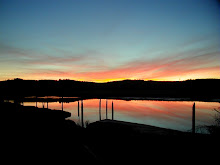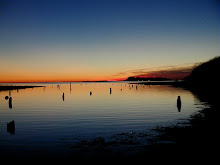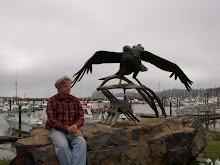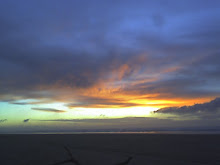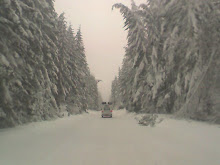BEFORE
Bear with me here. Nothing disrupts an early spring or summer day more than walking out to your trash bin only to discover that it has become a buffet for a bear (Black Bear) or big dog. There you are at 7 am in your sweats, robe, suit, or whatever and picking up stinky old this and that and tossing it back into the bin in hopes that the sanitation truck will come before the bear does. I got so good at detecting our Serena's tone of bark (she's a really big Border Collie) that I knew, I just knew, that in the morning, I was going to spend 15 minutes chasing down the trash that a bear (possibly big dog..but most likely a bear) spread all over the neighborhood.
I was bemoaning to Ilwacoan Truman Rew about the situation and how I was debating between putting the bin in a Fort Knox style enclosure or padlocking the bin lid shut. Truman said, "no big deal", "just go down to Dennis Company", "buy a hasp and put it on", and "the bear will knock it around like a soccer ball and give up".
So that's what I did. I bought a hasp, bent it to fit the bin, used a piece of scrap Trex (plastic wood) and wood 2 x 4 to secure the hasp and lock and most importantly, tested it to make sure that the hasp hangs free when open (important detail). As our bin had a crack in it, using backing material helped fix that too.
Here's a pic of the hasp in place. A narrow piece of Trex fit nicely between the lid and bin proper. I used short deck screws to fasten everything. The 2 x 4 is inside the bin and also fixed the crack.

This pic is of the hasp hanging free, an important detail not to be overlooked.

BIN vs Bears&Dogs: Ah, the bin rests victorious, asleep after a long brutal night of futbol with the bears. Better yet, score to date:

Bin 2 Bears&Dogs 0
The downside.
The downside.
- 1. IF YOU FORGET TO UNDUE THE HASP ON TRASH DAY...THE LID WILL NOT OPEN. Now you are under a week long trash siege and your spouse will be P.O.'d. This has happened to us twice in a year (oops). The truck drivers are smart and they'll see that your hasp is locked and the bin stays put.
- PENINSULA SANITATION will "officially" tell you it voids your contract on the bin as you've modified it. Unofficially, and off the record, they don't like garbage spread all over hell and gone either and they are sympathetic to the cause. ALWAYS UNDUE THE HASP. In my case, the bin was splitting apart and my repair job will add years to the life of the bin (as well as keep bears and dogs out).
- Your neighbors will wonder why you feel the need to lock your bin (actually, it might keep unwanted garbage from appearing in it as it does take a little extra effort to open it up).
- IF YOU FORGET TO UNDUE THE HASP ON TRASH DAY THE LID WILL NOT OPEN..get the picture.
And one more thing...Black Bears are very very strong. If they really wanted to, they'll open up a car like it was a paper bag so ultimately, this bin fix is as only good as the bear's willingness to give up after a few minutes, which has been the case. There is a lot of food on the beach and the bears are opportunists. That which is easy, they'll go for, that which is not so easy, they'll make an attempt.
Years ago I was in Yosemite National Park at the Ilwahnee lodge..and the NPS kept a nice little photo display of how Black Bears deal with cars that have food inside of them. Scary.









